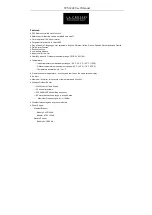
Version 2.0
©Copyright 2020, Ambient LLC. All Rights Reserved.
Page 33
Parameter
Range
Indoor Temperature
± 9 °F
Indoor Humidity
± 9%
Outdoor Temperature
± 9 °F
Outdoor Humidity
± 9%
Absolute Pressure
± 10 hpa (± 2.95 inHg)
Wind Direction
± 180 °
Wind Speed Factor
0.5 to 1.5
Rain Factor
0.5 to 1.5
Figure 28
6.10.3
Calibration Discussion
The purpose of calibration is to fine tune or correct for any sensor error associated with the devices
margin of error. Errors can occur due to electronic variation (example, the temperature sensor is a
resistive thermal device or RTD, the humidity sensor is a capacitance device), mechanical variation, or
degradation (wearing of moving parts, contamination of sensors).
Calibration is only useful if you have a known calibrated source you can compare it against, and is
optional. This section discusses practices, procedures and sources for sensor calibration to reduce
manufacturing and degradation errors. Do not compare your readings obtained from sources such as
the internet, radio, television or newspapers. The purpose of your weather station is to measure
conditions of your surroundings, which vary significantly from location to location.
Parameter
Type of
Calibration
Default
Typical Calibration Source
Temperature
Offset
Current Value Red Spirit or Mercury
Thermometer (1)
Humidity
Offset
Current Value Sling Psychrometer (2)
ABS
Barometer
Offset
Current Value Calibrated laboratory grade
barometer
REL Barometer Offset
Current Value Local airport (3)
Wind Direction
Offset
Current Value GPS, Compass (4)
Wind
Gain
1.00 Calibrated laboratory grade
wind meter (5)
Rain
Gain
1.00 Sight glass rain gauge with an
aperture of at least 4” (6)
Figure 29
(1)
Temperature errors can occur when a sensor is placed too close to a heat source (such as a
building structure, the ground or trees).
To calibrate temperature, we recommend a mercury or red spirit (fluid) thermometer. Bi-metal
(dial) and digital thermometers (from other weather stations) are not a good source and have
their own margin of error. Using a local weather station in your area is also a poor source due
to changes in location, timing (airport weather stations are only updated once per hour).
Place the sensor in a shaded, controlled environment next to the fluid thermometer, and allow
the sensor to stabilize for 48 hours. Compare this temperature to the fluid thermometer and
adjust the console to match the fluid thermometer.
















































